
La Ruche (literally the beehive) was an artist's residence in the Montparnasse district of Paris. It now hosts around fifty artists and stages art exhibitions open to the public. [1]

La Ruche (literally the beehive) was an artist's residence in the Montparnasse district of Paris. It now hosts around fifty artists and stages art exhibitions open to the public. [1]
Located in the Passage Dantzig, in the 15th arrondissement of Paris, La Ruche is an old three-storey circular structure that got its name because it looked more like a large beehive than a dwelling for humans. Originally a temporary building designed by Gustave Eiffel for use as a wine rotunda at the Great Exposition of 1900, the structure was dismantled and re-erected as low-cost studios for artists by Alfred Boucher (1850–1934), a sculptor, who wanted to help young artists by providing them with shared models and an exhibition space open to all residents. As well as to artists, La Ruche became a home to an array of drunks, misfits, drifters and people that just needed a place to stay. [2] [3]
At La Ruche the rent was cheap; and no one was evicted for non-payment. When hungry, many would wander over to artist Marie Vassilieff's soup kitchen (more genteelly called her cantine) for a meal and conversation with fellow starving artists. The Russian painter Pinchus Kremegne got off the train at the Gare de l'Est with three rubles in his pocket. The only words in French he knew was the phrase "Passage Dantzig"; but that was all he needed to get him there.
Like Montmartre, few places have ever housed such artistic talent as found at La Ruche. At one time or another in those early years of the 20th century, Guillaume Apollinaire, Alexander Archipenko, Joseph Csaky, Gustave Miklos, Alexandre Altmann , Ossip Zadkine, Moise Kisling, Marc Chagall, Max Pechstein, Nina Hamnett, Fernand Léger, Jacques Lipchitz, Pinchus Kremegne, Max Jacob, Blaise Cendrars, Chaim Soutine, Robert Delaunay, Amedeo Modigliani, Constantin Brâncuși, Amshey Nurenberg, Diego Rivera, Marevna, Luigi Guardigli, Michel Sima, Marek Szwarc and others, called the place home or frequented it. Today, works by some of these poorer residents and their close friends sell well, even in the millions of dollars. [4]
La Ruche went into decline during World War II; and by the time of the 1968 real estate boom, it was threatened with demolition by developers. However, with the support of well known artists such as Jean-Paul Sartre, Alexander Calder, Jean Renoir, and René Char, new management with a preservation mission took over in 1971, and turned it into a collection of working studios.
Its interior is not open to the general public, although many feel that the exterior of La Ruche alone is worth a visit. [5]

Montmartre is a large hill in Paris's 18th arrondissement. It is 130 m (430 ft) high and gives its name to the surrounding district, part of the Right Bank in the northern section of the city. The historic district established by the City of Paris in 1995 is bordered by rue Caulaincourt and rue Custine on the north, rue de Clignancourt on the east, and boulevard de Clichy and boulevard de Rochechouart to the south, containing 60 ha. Montmartre is primarily known for its artistic history, the white-domed Basilica of the Sacré-Cœur on its summit, and as a nightclub district. The other church on the hill, Saint Pierre de Montmartre, built in 1147, was the church of the prestigious Montmartre Abbey. On August 15, 1534, Saint Ignatius of Loyola, Saint Francis Xavier and five other companions bound themselves by vows in the Martyrium of Saint Denis, 11 rue Yvonne Le Tac, the first step in the creation of the Jesuits.
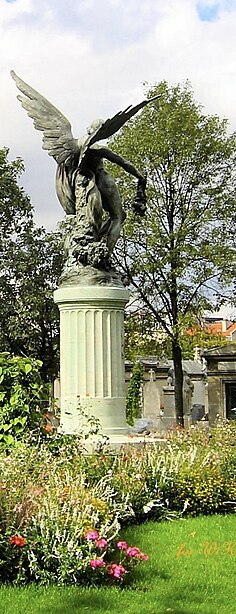
Montparnasse is an area in the south of Paris, France, on the left bank of the river Seine, centred at the crossroads of the Boulevard du Montparnasse and the Rue de Rennes, between the Rue de Rennes and boulevard Raspail. Montparnasse has been part of Paris since 1669.

Chaïm Soutine was a Russian painter who made a major contribution to the expressionist movement while living and working in Paris.
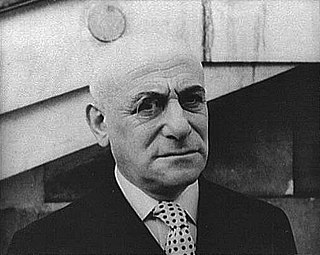
Max Jacob was a French poet, painter, writer, and critic.
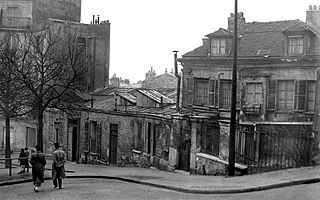
The Bateau-Lavoir is the nickname of a building in the Montmartre district of the 18th arrondissement of Paris that is famous in art history as the residence and meeting place for a group of outstanding early 20th-century artists, men of letters, theatre people, and art dealers. It is located at No. 13 Rue Ravignan at Place Emile Goudeau, just below the Place du Tertre.
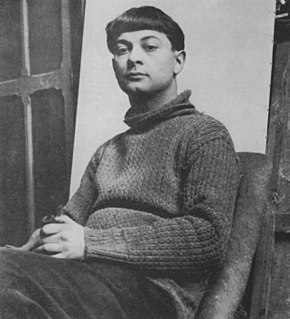
Moïse Kisling, born Mojżesz Kisling, was a Polish-born French painter. He moved to Paris in 1910 at the age of 19, and became a French citizen in 1915, after serving and being wounded with the French Foreign Legion in World War I. He emigrated to the United States in 1940, after the fall of France, and returned there in 1946.

Mariya Ivanovna Vassiliéva, , better known as Marie Vassilieff, was a Russian-born painter active in Paris.
Michel Kikoïne, was a Lithuanian Jewish-French painter.
Pinchus Krémègne, aka Pinchus Kremegne, was a Lithuanian Jewish-French artist, primarily known as a sculptor, painter and lithographer.

The Musée du Montparnasse was a museum at 21 Avenue du Maine, in the 15th arrondissement, Montparnasse Quarter of Paris, France. The museum closed in 2015.

School of Paris refers to the French and émigré artists who worked in Paris in the first half of the 20th century.
Marie Bronislava Vorobyeva-Stebelska, also known as Marevna, was a 20th-century, Russian-born painter known for her work with Cubism and pointillism.
Jan Wacław Zawadowski, pseudonym Zawado, (1891–1982) was a Polish painter, author of landscapes, still life compositions, portraits, figural scenes. He was a brother of Witold Eugeniusz and pupil of Józef Pankiewicz. Co-founder of the Cercle des Artistes Polonais in Paris.

Le Musée d'Art Moderne de Céret is a modern art museum in Céret, Pyrénées-Orientales, France, created by Pierre Brune and Frank Burty Haviland in 1950 with the personal support of their friends Pablo Picasso and Henri Matisse who were involved in its creation.
Sacha Zaliouk, born Alexander Davidovich Zaliouk (1887–1971), was a Russian Empire-born illustrator and sculptor, from a Jewish family in Radomysl, Ukraine. The Zaliouks were businessmen, artists, & musicians in this Zhitomer region from early in the 19th century. Many of them were fluent in both Russian & French.

Léon Indenbaum was a Russian sculptor and artist, born on 10 December 1890 at Chavusy (Belarus), died 29 September 1981 in Opio (France).
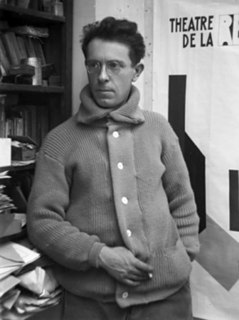
Joseph Csaky was a Hungarian avant-garde artist, sculptor, and graphic artist, best known for his early participation in the Cubist movement as a sculptor. Csaky was one of the first sculptors in Paris to apply the principles of pictorial Cubism to his art. A pioneer of modern sculpture, Csaky is among the most important sculptors of the early 20th century. He was an active member of the Section d'Or group between 1911 and 1914, and closely associated with Crystal Cubism, Purism, De Stijl, Abstract art, and Art Deco throughout the 1920s and 1930s.
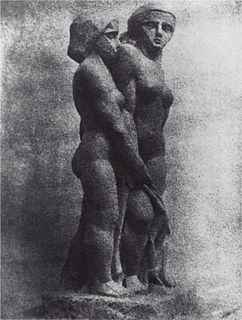
Groupe de femmes, also called Groupe de trois femmes, or Groupe de trois personnages, is an early Cubist sculpture created circa 1911 by the Hungarian avant-garde, sculptor, and graphic artist Joseph Csaky (1888–1971). This sculpture formerly known from a black and white photograph had been erroneously entitled Deux Femmes , as the image captured on an angle showed only two figures. An additional photograph found in the Csaky family archives shows a frontal view of the work, revealing three figures rather than two. Csaky's sculpture was exhibited at the 1912 Salon d'Automne, and the 1913 Salon des Indépendants, Paris. A photograph taken of Salle XI in sitiu at the 1912 Salon d'Automne and published in L'Illustration, 12 October 1912, p. 47, shows Groupe de femmes exhibited alongside the works of Jean Metzinger, František Kupka, Francis Picabia, Amedeo Modigliani and Henri Le Fauconnier.

Jean Lambert-Rucki (1888–1967), a Polish avant-garde artist, sculptor, and graphic artist, was best known for his participation in the Cubist, Surrealist and Art Deco movements. He exhibited at the 1913 Salon d'Automne in Paris; from 1919 was represented by both Léonce Rosenberg at the Galerie de l'Effort Moderne and the art dealer Paul Guillaume. In March 1920, Lambert-Rucki exhibited at the second exhibition of la Section d'Or, Galerie de La Boétie, Paris, and participated in the first exhibition of l'Union des Artistes Modernes, where he would continue to show his works. Working in diverse styles and media, at times influenced by the tribal art of Africa, Lambert-Rucki became well known for his Cubist cityscapes.

Fernande Barrey was a French artist model and painter.